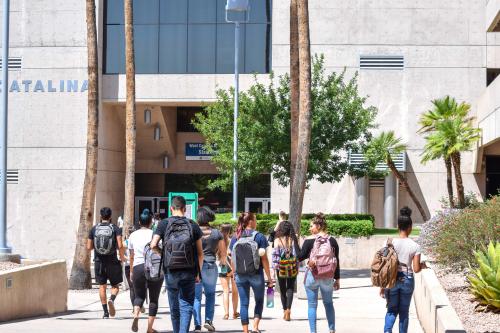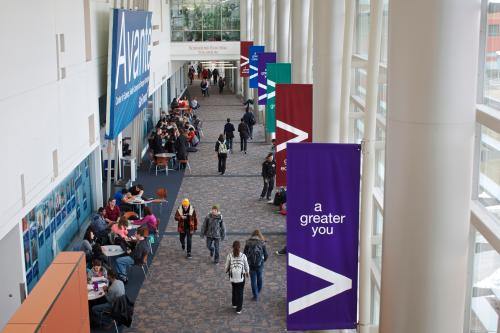This post was produced in collaboration with the academic journal Educational Evaluation and Policy Analysis.
Since the onset of the COVID-19 pandemic, community colleges across the country have grappled with substantial enrollment declines. Even with the resumption of in-person learning at many institutions last fall, community college enrollment is 6% lower than fall 2020 and 14.8% lower than fall 2019. College enrollments had been slowly declining through much of the 2010s, in part stemming from demographic trends toward a smaller population of traditional college-age youth, though the pandemic further accelerated these trends.
In the face of these challenges, many states and colleges have looked increasingly to older adult populations to offset enrollment declines among the youngest adults. Numerous states have made substantial policy investments to increase enrollment among older adults; a prominent example is Tennessee Reconnect, a state-funded, last-dollar scholarship program targeted specifically to adults 25 and older in Tennessee.
Increasing state investments in older adult enrollment (or re-enrollment) is driven in part by data suggesting that, across the United States, there are tens of millions of adults with some college credits but no degree or credential. From a policy perspective, this population seems like low-hanging fruit to increase college enrollment and graduation. These students have already participated in college and made progress toward a credential, so they have demonstrated some inclination and potential for postsecondary success. The monetary benefits of a college-level credential are large and growing, so supporting adults to finish would presumably improve their labor-market prospects.
And yet, existing evidence suggests that efforts to increase enrollment and re-enrollment among adults have had limited success. For instance, sending former community college students in Florida text messages with information about re-enrollment had no effect on adults coming back to college; including tuition waivers only led to a modest increase in re-enrollment. Why wouldn’t more adults choose to complete their programs, given the numerous benefits associated with earning a credential?
To shed light on why more adults do not finish community college, we investigated the labor-market trajectories of adults who had earned some college-level credits from the Virginia Community College System (VCCS) but who stopped out before completing their credential. Our analysis includes students who left VCCS between summer 2009 and spring 2014 and did not re-enroll or attend a different institution for at least three years.
Several key insights emerge from our analysis:
- Many adults exit college with some credits, but most of them may not be academically ready to succeed in postsecondary education. Among the cohorts we focus on in our analysis, nearly 200,000 students had earned at least some college credits and left their community college without earning a college-level credential (including associate degrees and certificates). But fewer than one in seven had earned at least 30 college-level credits and maintained a cumulative GPA of 2.0 or higher prior to their departure. This suggests that the large majority of adults with some college credits but no credential would have multiple semesters of re-enrollment ahead of them to graduate and/or may struggle to maintain satisfactory academic progress to advance toward completion.
- After leaving college without a credential, students with substantial academic progress typically experience steadily increasing wages. Among adults for whom we can observe labor-market outcomes and who earned at least 30 college credits and maintained a GPA above 2.0 prior to stopping out, the average student was earning approximately $5,000 per quarter in the year leading up to when they stopped out from college. By five years after stopping out, quarterly wages nearly doubled, on average. While these upward earnings trends may have been disrupted during COVID-19 for many adults with credits but no credential, these trajectories may still inform why some adults have historically not felt an economic necessity to complete their program of study.
- Most students with substantial academic progress who left college without a credential were in a field of study without significant earnings premia associated with completion. Of 19 fields of study with sufficient sample sizes for us to precisely estimate earnings differentials between adults who do and do not graduate, only six had significantly higher earnings among graduates. This suggests that many adults who left college without a credential may have been making reasonable inferences about the labor-market value of the credential they would have earned had they stayed in college to complete their program of study—and may also inform why more of these adults have not subsequently chosen to re-enroll and finish.
These combined results highlight that the share of adults with some credits but no credential who might be receptive to and would benefit from re-enrollment efforts may be substantially lower than policymakers anticipate. In fact, our analyses suggest that, among adults who made substantial academic progress before stopping out of college, fewer than 1,000 adults of approximately 26,000 in our analysis (about 3%) could fairly easily re-enroll in fields of study from which they could reasonably expect a sizable earnings premium from completing their credential.
Increasing re-enrollment and success among adults would, therefore, require a comprehensive and likely resource-intensive strategy. One important area to start is to reduce stop-out among adults with substantial credits. We find that a sizeable share of adults who leave college were performing well academically for most of their terms in college, but they experienced a substantial decline in performance in the term immediately preceding their departure. Investing resources to identify students whose academic performance suddenly declines and to intervene with additional supports could lead more adults to stay on track for completion. Both for adults who have yet to stop out and those who left college years earlier, interventions should draw on existing evidence-based approaches to increase completion among higher-risk student populations, including: intensive coaching and advising; structured learning and financial supports like CUNY ASAP; and increased grant assistance to improve college affordability.
You can read the full journal article in Educational Evaluation and Policy Analysis: “Unfinished Business? Academic and Labor Market Profile of Adults With Substantial College Credits But No Degree.“









Commentary
Why aren’t more adults finishing community college?
And can we get them back in the classroom?
January 24, 2022